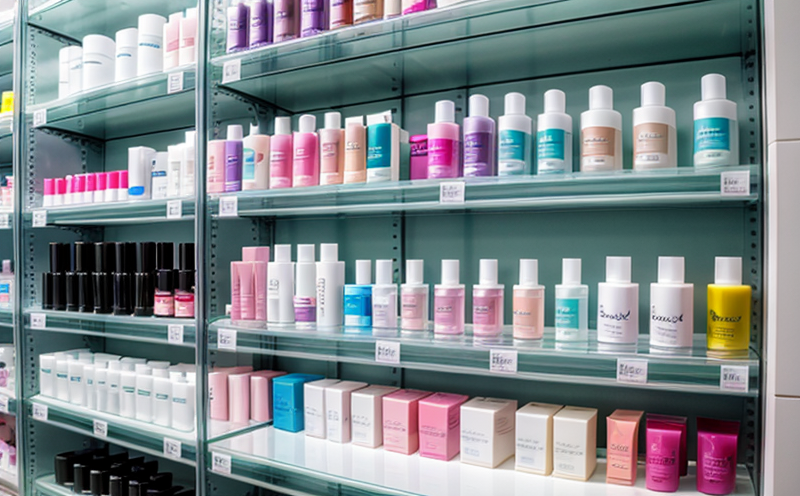Volatile Compound Stability Testing in Perfumes
In the fast-paced world of cosmetics and fragrances, ensuring the stability and longevity of volatile compounds is paramount. Volatile compounds, such as alcohols, esters, and terpenes, are integral to the unique scents that define perfumes. These compounds not only contribute to the olfactory experience but also play a critical role in the overall product performance over time. This testing service focuses on evaluating how these volatile components behave under various environmental conditions, ensuring consistent quality and compliance with international standards.
The process begins with meticulous sample preparation, where the perfume is divided into aliquots representing different storage conditions such as high temperature, humidity, light exposure, or combinations thereof. Once prepared, these samples are subjected to rigorous testing using advanced analytical techniques like gas chromatography-mass spectrometry (GC-MS), which can detect even trace amounts of volatile compounds.
The stability of each compound is assessed over a predetermined period, typically ranging from weeks to months, depending on the desired shelf life and market expectations. This duration allows for comprehensive evaluation of how well the perfume retains its original composition under real-world conditions. The data collected during these tests are then used to predict long-term behavior, thereby aiding in product development.
Understanding the stability profile helps manufacturers optimize formulation design, choose appropriate preservatives, and select suitable packaging materials that can protect against light, heat, or other environmental factors. By identifying potential degradation pathways early on, companies can prevent costly recalls and maintain consumer trust.
Compliance with international standards such as ISO 2631-1:2003 is crucial for ensuring the safety and efficacy of cosmetic products worldwide. These standards provide guidelines that manufacturers must adhere to when conducting stability studies. Adherence ensures that the results are comparable across different regions, enhancing market entry strategies.
The importance of this service extends beyond mere compliance; it significantly impacts brand reputation and customer satisfaction. Consumers expect high-quality, consistent experiences with their favorite products. By investing in thorough testing, brands demonstrate a commitment to excellence, which translates into loyal customers and favorable reviews.
| Environmental Factor | Impact on Perfume Stability | Testing Methodology |
|---|---|---|
| Temperature | Increases reaction rates of volatile compounds | Accelerated Stability Testing (ASTM D7192) |
| Humidity | Can enhance microbial growth affecting stability | Bacterial and Fungal Growth Studies |
| Light Exposure | Promotes photochemical reactions leading to degradation | Sunlight Exposure Simulation (ISO 12374) |
| Oxygen | Facilitates oxidation processes that lead to color changes or loss of fragrance | Headspace GC-MS Analysis |
The ability to predict and mitigate potential issues through thorough testing not only enhances product quality but also supports sustainable practices by reducing waste associated with premature expiration. This service plays a vital role in ensuring that perfumes meet both consumer expectations and regulatory requirements, contributing positively to the cosmetic industry's reputation.
International Acceptance and Recognition
The stability testing of volatile compounds in perfumes is widely recognized and accepted across international markets. Many countries have adopted standards such as ISO 12374 for sunlight exposure simulation and ASTM D6970-18a for accelerated aging tests, which are essential for evaluating the shelf life of cosmetic products.
These internationally recognized standards provide a common framework that ensures consistency in testing methodologies. Compliance with these standards not only facilitates easier market entry but also enhances consumer confidence by ensuring that products meet global quality benchmarks. Regulatory bodies like the European Union’s Cosmetics Regulation (EC 1272/2006) and the U.S. Food and Drug Administration (FDA) regulations also emphasize the importance of stability testing, particularly for volatile compounds.
International acceptance extends beyond mere compliance; it fosters a culture of excellence within the industry. Companies that adhere to these standards are often seen as leaders in their field, gaining competitive advantages through enhanced product quality and reputation. This recognition can lead to increased market share and long-term brand loyalty.
Environmental and Sustainability Contributions
Incorporating volatile compound stability testing into the cosmetic development process offers significant environmental benefits. By ensuring that perfumes maintain their integrity over extended periods, companies reduce unnecessary production and disposal cycles. This minimizes waste generation and promotes a more sustainable approach to product lifecycle management.
The use of advanced analytical techniques like GC-MS allows for precise monitoring of volatile compound degradation, leading to optimized formulations that require minimal adjustments during the shelf life. This efficiency not only reduces resource consumption but also lowers energy costs associated with production processes.
Furthermore, by predicting potential issues early in the development stage, companies can implement preventive measures such as selecting appropriate packaging materials or formulating products using stabilizers. These actions contribute to a circular economy model where resources are used efficiently and waste is minimized.
The commitment to sustainable practices through rigorous testing aligns with broader industry trends towards environmental responsibility. Consumers increasingly value eco-friendly products, making it essential for companies to adopt sustainable strategies in their product development processes. Stability testing plays a crucial role in achieving these goals by ensuring that perfumes not only meet current standards but also contribute positively to future generations.





